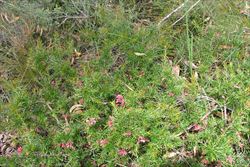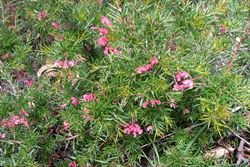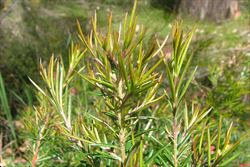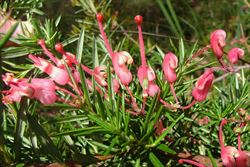Click on images to enlarge

infestation (Photo: Sheldon Navie)

habit (Photo: Sheldon Navie)

leaves and flower clusters (Photo: Sheldon Navie)

leaves (Photo: Sheldon Navie)

young growth (Photo: Sheldon Navie)

close-up of stem and leaf undersides (Photo: Sheldon Navie)

close-up of flowers (Photo: Sheldon Navie)

Grevillea lavandulacea, or a hybrid between it and Grevillea rosmarinifolia subsp. rosmarinifolia (Photo: Sheldon Navie)
Scientific Name
Grevillea rosmarinifolia A. Cunn. subsp. rosmarinifolia
Synonyms
Grevillea latrobei Meisn.Grevillea rosmarinifolia A. Cunn.
Family
Proteaceae
Common Names
rosemary grevillea, rosemary-leaved grevillea, spider flower
Origin
Native to south-eastern Australia (i.e. southern and central New South Wales and northern Victoria).
Cultivation
Rosemary grevillea (Grevillea rosmarinifolia subsp. rosmarinifolia) is widely cultivated as a hardy shrub in temperate climates. Several forms and cultivars are known in cultivation, including 'Desert Flame', 'Lara', 'Lara Dwarf', 'Limelight', 'Rankin Springs' and 'Rosy Posy'. This species is also one of the parents of many of the popular hybrid grevilleas, some of which have also escaped cultivation.
Naturalised Distribution
Naturalised in south-eastern South Australia, the ACT, south-eastern Queensland and beyond its native range in southern Victoria.
Habitat
Grows naturally in woodlands near streams and on moist slopes, and in mallee and shrublands on sandy soils in the temperate regions of Australia. A weed of grasslands, open woodlands and rocky slopes in temperate and occasionally also cooler sub-tropical regions.
Habit
A small to moderately large shrub usually growing 0.3-2 m tall.
Distinguishing Features
- a small to moderately large shrub growing 0.3-2 m tall.
- its long and narrow leaves (0.8-3.8 cm long and 0.5-3 mm wide) have margins that are curled under.
- its flowers are usually borne in regular pairs along the branches of the flower clusters.
- these flowers are pink to red in colour, sometimes cream near their tips, and are curved downwards.
- they have a prominent style that is enlarged towards its tip.
Stems and Leaves
The elongated (i.e. narrowly-elliptic or narrowly-oblong) to very narrow (i.e. linear) leaves are alternately arranged along the stems. These small leaves (0.8-3.8 cm long and 0.5-3 mm wide) have margins that are curled under (i.e. revolute), which partly or wholly conceal the lower leaf surface. Their upper surfaces are hairless and their lower surfaces are either loosely covered with some silky hairs (i.e. sub-sericeous) or hairless (i.e. glabrous).
Flowers and Fruit
The flower clusters may be branched or unbranched, each branch bearing one to many flowers (i.e. in racemes or conflorescences). Flowers are usually borne in regular pairs along the branches of the flower clusters. They have four 'petals' (i.e. perianth segments or tepals) that are pink to red in colour, or sometimes cream near their tips. These 'petals' are hairless (i.e. glabrous) on the outside and hairy (i.e. bearded) on the inside. They are fused together into a tube (i.e. perianth tube) that is curved downwards (i.e. recurved) and eventually partially splits apart. The flowers have four stalkless (i.e. sessile) stamens that are fused onto the inside of the 'petals' and often difficult to see. They also have an ovary topped with a prominent style that protrudes well beyond the rest of the flower. This style is hairless (i.e. glabrous) or only slightly hairy (i.e. puberulent) and swollen near its tip. Flowering occurs mainly during spring, but occasionally in late winter or early summer (i.e. from August to December).
The fruit (i.e. follicle) is usually hairy, turning from green to brown in colour as it matures. When fully mature it splits open to release its seeds.
Reproduction and Dispersal
This species reproduces only by seed. Its seeds may be dispersed by ants, wind and water.
Environmental Impact
Rosemary grevillea (Grevillea rosmarinifolia subsp. rosmarinifolia) is regarded as an environmental weed in South Australia, the ACT, and those parts of Victoria outside its native range. It forms dense clumps that can smother patches of native grassland and take over the shrub layer of open woodlands. Of greater concern is the fact that this garden escapee also spreads into areas where native grevilleas are located. It often hybridises with the locally indigenous species, polluting their genetic integrity and even threatening the survival of rarer species.
Rosemary grevillea (Grevillea rosmarinifolia subsp. rosmarinifolia) is currently of most concern in south-eastern South Australia, where it is a common environmental weed of the Greater Adelaide region and Mount Lofty Ranges. For example, it is listed as an invasive plant in bushland in the Adelaide Hills Council District and has become naturalised in Mount George Conservation Park. Rosemary grevillea (Grevillea rosmarinifolia subsp. rosmarinifolia) also hybridises with the lavender grevillea (Grevillea lavandulacea subsp. lavandulacea), which is locally native to this region. These hybrids are becoming common in bushland in this area, including in conservation areas (e.g. Angove Conservation Park), and have also been recorded in some parts of Victoria. This interbreeding problem is degrading the genetic viability of the native species, and there is concern that the lavender grevillea (Grevillea lavandulacea subsp. lavandulacea) could eventually become locally extinct in this parts of South Australia.
Rosemary grevillea (Grevillea rosmarinifolia subsp. rosmarinifolia) is a commonly sold and cultivated species in the ACT. It naturalises very readily from plantings and is establishing over wide areas in the region, from the rocky slopes of Molonglo Gorge to grassland areas close to planted specimens. This species is thought to be a long-term ecological threat to the Molonglo Gorge Reserve and is also spreading from the Canberra Botanic Gardens into adjacent eucalypt and cypress pines woodlands, particularly where the canopy has been thinned by past clearing or fire. It has also hybridised with the local juniper-leaf grevillea (Grevillea juniperina subsp. fortis). This hybrid is now thought to be the most common grevillea on Red Hill in Canberra, and also occurs on the lower slopes of Mt Ainslie.
Rosemary grevillea (Grevillea rosmarinifolia subsp. rosmarinifolia) is also becoming a problem in southern Victoria. For example, it has been reported from bushland reserves in Melbourne's eastern fringe and the Dandenong Ranges. It is also listed as an environmental weed in some areas (e.g. in Knox City and the Goulburn Broken Catchment) and is present in the Brisbane Ranges National Park, west of Melbourne. This species is also present at some of the sites where the endangered Wee Jasper grevillea (Grevillea iaspicula) is found on the New South Wales Southern Tablelands. Though rosemary grevillea (Grevillea rosmarinifolia subsp. rosmarinifolia) may be native to this particular area, hybridisation between these two closely-related species occurs, affecting the genetic purity of the rarer of the two species and possibly threatening its survival.
Legislation
Not declared or considered noxious by any state government authorities.
Similar Species
Rosemary grevillea (Grevillea rosmarinifolia subsp. rosmarinifolia) is very similar to several other native grevilleas, including some very rare species with which it has been confused in the past. It is also very similar to numerous cultivated hybrids as well as some naturally occurring hybrids. These often have rosemary grevillea (Grevillea rosmarinifolia subsp. rosmarinifolia) as one of the parent species, and therefore may display characters that are intermediate between rosemary grevillea (Grevillea rosmarinifolia subsp. rosmarinifolia) and the other parent species. For this reason an expert or specialist text should be consulted.
In general, though, rosemary grevillea (Grevillea rosmarinifolia subsp. rosmarinifolia) can be distinguished by its long and narrow leaves, which have smooth and hairless upper surfaces, and by the fact that its flowers are not very hairy (i.e. the ovaries, styles and outsides of the petals are hairless or only slightly hairy). Many of the other similar plants can be separated by one or more of the following differences:
- shorter and broader leaves,
- leaf upper surfaces that are hairy or bumpy (i.e. tuberculate),
- leaf undersides that are densely hairy,
- hairy ovaries and/or styles, and
- the hairy outer surfaces of their 'petals'.

